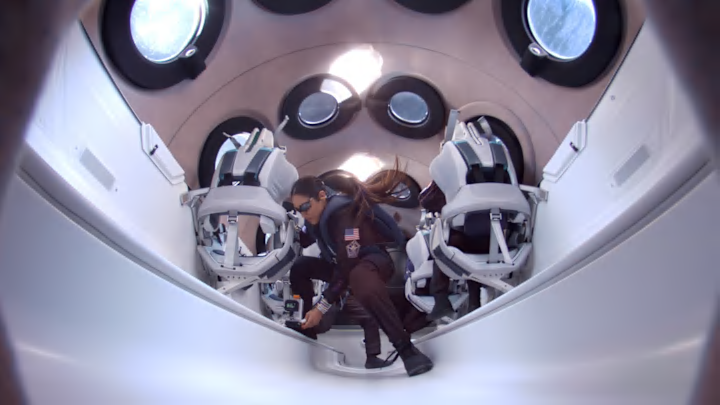The era of commercial spaceflight is upon us. For the right amount of money, companies like SpaceX will take anyone to see the Earth from above, and in 2019 new NASA regulations allowed the International Space Station to participate in product sponsorships from brands like Estée Lauder, Mattel, and Adidas. But for Kellie Gerardi, the private-sector space industry offers more than just a joyride or a marketing opportunity. It represents a “new space age” of microgravity research and accessibility.
Gerardi was one of two bioastronautics researchers on Virgin Galactic’s recent Galactic 05 mission, a one-hour suborbital spaceflight focused on microgravity research. It was Virgin Galactic’s sixth spaceflight in six months and its last of 2023. The flight, which reached an altitude of 54 miles above Earth, was an “adrenaline-pumping” experience with a liftoff right out of a science fiction novel, Gerardi tells Mental Floss, and the culmination of her decade-long career in various roles in the commercial space sector, including working on space policy, hardware, business development, and research. But she’s just getting started.
More Than Just Tourism
Bioastronautics is the study of human life support in space, harnessing biology, psychology, engineering, and other fields to design survival systems for spaceflight. During Gerardi’s mission, sponsored by her team at the International Institute for Astronautical Sciences (IIAS), she conducted experiments on the behavior of liquids in low gravity that could help scientists improve medication administration for astronauts, among other things. She also wore multiple biosensors to reveal the impact of microgravity on the body, monitoring factors like her heart rate, skin temperature, and blood glucose levels. The findings should help pave the way for increasingly extended, comfortable space excursions like human-crewed Mars missions.
Private-sector research flights like the Galactic 05 mission give research institutions an alternative path to space and, hopefully, more accessible opportunities to study conditions like microgravity, Gerardi says. They “represent the beginning of a new era of access to space for the research community,” she says—a “goldilocks solution” to current research barriers like the expense of the International Space Station.
Her take may be different from the common view of commercial spaceflight as simply space tourism, a pastime for only the wealthiest people that symbolizes economic inequality.
Gerardi, though, views figures like billionaire Blue Origin founder Jeff Bezos as “patrons” of the budding industry, part of the broader commercial space environment. Without their investments, research like hers would remain limited, she says, and the market they create ultimately benefits larger efforts to explore and understand our universe.
That’s not to say that she doesn’t appreciate the role of the government in space exploration. She highlights the historic achievements of NASA as an example of the ongoing value of public institutions. “For humanity’s sake, we need government leading us in exploration where the horizon is unclear,” she says. “To explore, you know, what exists in an ocean on Europa. Those are the types of things that don’t necessarily have a business case behind them. We benefit as a species from having government institutions lead the way towards extraordinary leaps and bounds for humanity.”
“Everybody’s Talents Play a Role”
Initially, the commercial space industry’s efforts toward accessibility “took grip in [her] soul” and convinced Gerardi to pursue her dreams of space research in a business still dominated by men. As of 2021, only one in five workers in space-related industries were women. The proportion of women going to space itself is even smaller: Fewer than 100 women have flown in space, making up only 11 percent of the world’s astronauts and 6.6 percent of those who have been active outside of a spacecraft.

For Gerardi, this meant a long struggle to overcome unconscious mental limits. “I had all this exposure to the world [of STEM],” she says, “but my own schema of understanding—like, ‘What is an astronaut?’ ‘What do they look like?’ ‘What do they sound like?’ ‘What do I picture when I close my eyes and think, ‘astronaut’?—was a very different picture than what I saw when I looked in the mirror.”
This inner journey is part of what prompted Gerardi to write her Luna Muna series of children’s books, featuring a young, overtly “girly” female astronaut. She aims to bridge the representation gap for younger generations, and especially her own daughter, Delta. “The difference that I see is that my daughter doesn’t have to adjust anything in her own imagination,” she says. “When I ask Delta to draw an astronaut, she draws a woman.” Gerardi looks forward to seeing what future generations of women will achieve when they have the “confidence to start out their journeys knowing that all of these paths are available to them.”
Increasing access to space—both for researchers and for underrepresented groups—is not only a worthy goal but a necessary one to Gerardi. Creating a utopian, Star Trek future will take people of all different backgrounds and skills coming together, she says. “Space is so innately aspirational and inspirational,” she adds. “This is humanity’s next giant leap. Everybody’s talents play a role in getting us to that next chapter.”
Gerardi and her research institute plan to fly again with Virgin Galactic, continuing her research into microgravity and novel medical technologies. You can stay updated on her missions through Instagram and TikTok and read more about her career journey in her memoir, Not Necessarily Rocket Science: A Beginner’s Guide to Life in the Space Age.
